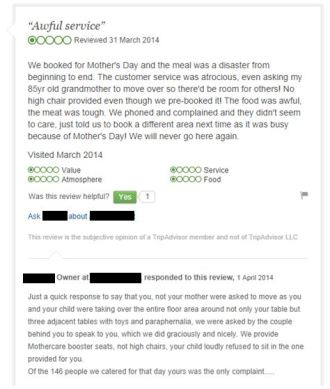 Let’s be honest…
Let’s be honest…
You only own a very small share of your brand presence. The part that you own is what you tell the world. The rest is down to what the world says about you.
When your target audience wants to know more about your business, it has access to a wealth of information across a wide range of channels – many of which you have little or no control over.
Market initiated channels
- Social Media

For many, LinkedIn and Twitter are now the first ports of call for learning about businesses and products. Although you can of course control what is being said on your own official social media channels, you cannot restrict what other people are saying about you. Stay aware of what is being discussed and respond to genuine queries in an official manner – but avoid the trap of defending yourself in every instance or you will simply appear arrogant and deprecating, like this restaurateur for example.
- Glassdoor
Employee reviews are becoming more prevalent through channels such as Glassdoor, where people can give anonymous comments and feedback on their experience working in a particular business. And this is no longer just a jobseeker’s resource – we now see prospects and customers looking at vendors’ profiles on Glassdoor to gauge internal efficiency and optimism levels amongst staff, which then reflects on their views of the business.So what do you do if you have bad reviews? Well, the best way to manage this is to read them, raise them internally and make tangible plans to resolve them. Don’t be afraid to ask staff to use these types of sites – it can be the best driver for improvement you’ll ever have.
- User forums
Whether or not you are aware of it, it is likely that there are independent forums online for customers discussing your products. Some may be public, such as general DIY websites or money saving forums for example, while others could be private and more product or brand specific. Again, you may want to monitor what is being said – where possible – and then aim to incorporate any complaints areas or suggested improvements into your roadmap.
Vendor initiated channels
- Net Promoter Score (NPS) surveys
This is the company or service provider’s chance to proactively collect the sentiments of their customers to get a full and impartial view of what is done well and not so well. Apart from the fact that a positive NPS carries a substantial weight when it comes to credibility and market confidence, the qualitative feedback from customers can also provide extremely valuable input into how to better serve them. A company should always share their score with their customer base, accompanied by an executive summary outlining which actions the business will be taking as a result of the input.
- PR
Public Relations, in all its many guises, is where a company could spend a great deal of funds on creating the image which they want the public to subscribe to. And although this can go a long way to rectify a negative market view or reclaim customer confidence, the general public is becoming increasingly shrewd to identifying PR as a strategy – and will seek to complement the PR messaging with more nuanced, unbiased peer review.
- Analyst reports
The analyst community aims to support vendors in their market positioning, while maintaining a balanced messaging environment based on a true representation of market perception. However, as with PR, customers are aware that there is an element of bias in the sense that the analyst is influenced by the amount of face time with the vendor and by how the vendor conducts themselves in the analyst relationship.
- Content syndication
The purpose of syndication is to make marketing content available in locations where customers go to research information to base purchasing decisions on. The majority of the buyer journey currently takes place before they even speak to the vendor, so content syndication is an important channel for organisations to be discovered and researched. This is why it makes sense to create collateral that informs and influences rather than purely sells – as the customer doesn’t want to be sold to at this stage. They just want to learn.
Conclusion
Amidst this wealth of content, the most trusted source of advice for many customers is that of professional peers. We all look at what other, similar businesses are doing and what their views are. We then collate comparisons between products and weigh this against any purchased or vendor-driven media. This is why a business can spend thousands on content marketing and still see limited sales impact.
You may think your brand is yours, but it’s not!
